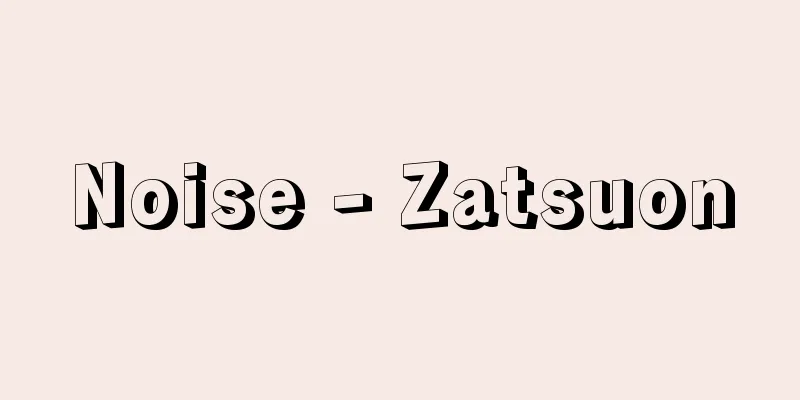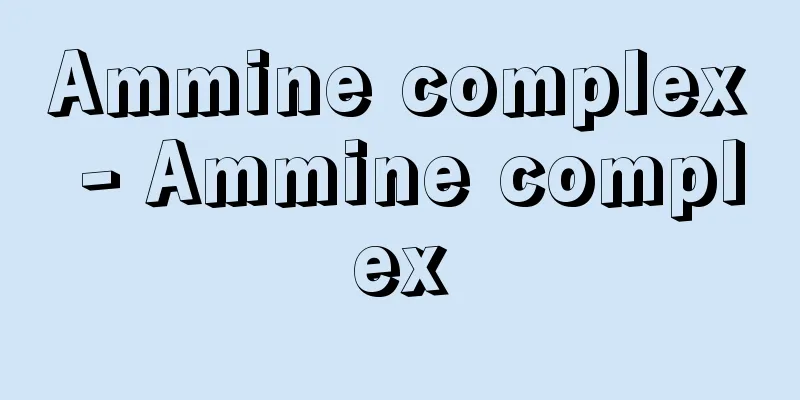Noise - Zatsuon

|
Originally, the term "noise" meant any sound that was unpleasant to the ear (acoustic noise), but in this sense the term "noise" has become established. Rather, with the development and spread of telecommunications, "noise" is now widely used to mean noise caused by electrical equipment (electric noise) that interferes with the reception of desired signals, or noise received as radio waves due to natural or man-made causes (radio noise). It can also refer more broadly to anything that interferes with the acquisition of desired information. For example, neon signs in the background of traffic signals and extraneous light reflected on a television screen can also be considered noise, but the term "visual noise" has not yet been established. A specific example is when listening to the radio, you may hear unnecessary noises such as scratching or hissing. Or when a car or other vehicle passes nearby, countless dots may appear on the television screen, making it difficult to see. Such phenomena occur when some internal or external cause within the receiver or measuring instrument disturbs the intended electrical signal, causing the voltage or current to fluctuate irregularly. This disruptive electrical disturbance is called noise. Note that interference caused by other broadcasting or communication signals is called crosstalk or interference, and is generally distinguished from noise. [Noboru Wakai] Classification by causeNoise can be broadly classified based on its source into internal noise, which is generated from within the receiver, etc., and external noise, which mixes in from the outside and causes interference. [Noboru Wakai] Internal noiseTypical examples are noise generated by resistors and semiconductors. The mechanism by which these noises are generated is the same as that of noise generated by vacuum tubes and the like, and is the most basic. The current flowing through a resistor is due to the movement of internal conduction electrons, but even without the application of an external voltage, the electrons undergo irregular thermal motion, causing a minute voltage that constantly fluctuates across the resistor. This is called thermal noise (Johnson noise, resistor noise), and the mean square value of this voltage is proportional to absolute temperature and is constant up to extremely high frequencies. This noise is theoretically present in any resistor, but can be reduced by lowering the temperature. When a voltage is applied to a transistor or vacuum tube, a large number of carriers (electrons and holes) move and a current flows, but because the movement of each carrier occurs independently and irregularly, the current as a whole fluctuates. This is called shot noise, and its magnitude depends on the average current, and is constant up to a frequency range where the carrier transit time can be ignored. There is also flicker noise, a type of vacuum tube noise that is problematic in the low-frequency range below a few tens of kilohertz. This is thought to be caused by a slow change in the surface condition of the cathode, which causes fluctuations in the electron emission ability. Its magnitude depends on the average current, is roughly inversely proportional to the frequency, and is significant in the low-frequency range. As frequencies increase and we enter the optical domain, quantum noise, or noise caused by the particle nature of light, becomes more prominent than thermal noise, and this noise is also a problem at extremely low temperatures. [Noboru Wakai] External noiseWhen classified according to the cause of external noise, it can be broadly divided into natural noise caused by natural phenomena and man-made noise generated by various electrical devices, power lines, automobiles, etc. [Noboru Wakai] Natural noiseAtmospheric noise, which is a type of natural noise, includes noise generated by lightning discharges in the atmosphere (sciphers) and noise generated by the attachment or accumulation of electric charges from water droplets, sand grains, snow particles, etc. (precipitation noise). Among them, sciphers are the strongest and affect the reception of ionospheric propagation waves such as long-wave standard time radio waves, medium-wave broadcast waves, short-wave broadcast waves, and short-wave communication waves. The components of sciphers are made up of distant thunder (continuous noise generated in tropical regions and arriving through the ionosphere) and local thunder (noise containing impulse components from nearby thunder). Solar noise emitted from the sun and galactic noise emitted from celestial bodies in the galaxy are called cosmic noise, and these affect space communications and radio astronomy observations. Thermal noise from the atmosphere and earth also becomes a problem in the frequency band above several hundred megahertz, where cosmic noise becomes small. Below is a summary of the types of natural noise. (1) Atmospheric noise (atmospheric noise, atmospheric thermal noise, volcanic plumes, deposition noise) Artificial noiseMan-made noise is thought to be generated from all devices and facilities that use electricity, including household electrical appliances, automobiles, trains, and power lines. In frequency bands below several tens of megahertz, power line noise is the main noise source, while in higher frequency bands, automobile noise is the main noise source. However, the types, sizes, numbers, locations, and times of noise sources are extremely diverse and localized, making it difficult to show general trends regarding man-made noise. Below is a summary of the types of man-made noise. (1) Spark discharge noise (ignition systems in automobiles, thermostats, relays) Classification by natureNoise can be classified according to its waveform into impulse noise and continuous noise. The former is found in man-made noise such as noise caused by nearby thunder or automobile noise, and consists of short pulses. The latter refers to noise with a continuous waveform, such as thermal noise or shotgun noise. However, this classification is not very clear and depends on the receiver's bandwidth and the frequency of pulse generation. Noise can also be classified as periodic or nonperiodic. Noise with irregular waveforms, such as internal noise, is nonperiodic, while hum noise caused by power supply induction, automobile noise, and power line noise can be considered periodic. Noise can also be classified according to its spectrum. Noise with a uniform spectrum within the receiver's bandwidth, such as thermal noise, shotgun noise, and automobile noise, is called white noise, while noise that does not is sometimes called colored noise. [Noboru Wakai] Quantitative ExpressionNoise waveforms are irregular and complex, making it difficult to express their magnitude unambiguously, but the following measurement quantities are generally used: The RMS value is the square root of the root mean square value of the noise amplitude over a certain period of time, and this value is related to the average power of the noise. The peak value is the maximum value of the noise amplitude over a certain period of time. The quasi-peak value is a value close to the peak value measured by a specific detection circuit. Furthermore, there are also expressions using the average value and the amplitude distribution function of the noise waveform. In many cases, these values depend on the bandwidth of the measuring instrument. The internal noise of an electric circuit such as an amplifier is often expressed by a value related to power (such as an effective value). Furthermore, since the sensitivity of an amplifier is limited by the internal noise, the performance of the amplifier is expressed by the noise figure, which indirectly indicates the magnitude of the internal noise. The noise figure is the value obtained by dividing the signal-to-noise ratio (SN ratio) on the input side by the signal-to-noise ratio on the output side, and if there is no internal noise in the circuit, it is 1 (0 decibels). For example, in a VHF television receiver, it is about 5 to 7 decibels. Natural noise is generally received by an antenna, and the strength of the natural noise is expressed by the temperature (equivalent noise temperature) of a resistor that generates thermal noise equivalent to the noise power received by a lossless antenna. It can also be expressed by the external noise figure, which is the equivalent noise temperature divided by a reference temperature. The strength of man-made noise generated from household electrical appliances, receivers, automobiles, power lines, trains, etc. is generally expressed as a quasi-peak value. Since this quasi-peak value depends heavily on the characteristics of the measuring device, the International Special Committee on Radio Interference (CISPR) internationally defines the standards for measuring devices. In Japan, there is a standard based on this, proposed by the former Ministry of Posts and Telecommunications' Radio Technology Council (the council was succeeded by the Ministry of Internal Affairs and Communications' Information and Communications Council in January 2001). Specific measurement methods and allowable values for noise from various devices and facilities are also determined by CISPR and relevant domestic regulations. If the noise generated is radio noise, the electric field strength is measured, and if it is conductive noise that travels through power lines, the voltage and current are measured. [Noboru Wakai] Noise ReductionMeasures to prevent noise generation require reducing the noise source, providing adequate shielding, and inserting blocking filters in power lines, etc. On the other hand, to prevent external noise from entering receivers, etc., noise sources must be kept away, shielding and power filters must be used, and the passband width at the receiver input end must be reduced to a minimum, and noise suppression circuits may also be used. It is also important to adopt information transmission methods that are resistant to noise, such as frequency modulation. [Noboru Wakai] "Noise: Sources, Characteristics, Measurement" by A. van der Ziel, translated by Hirano Nobuo (1973, Tokyo Denki University Press)" ▽ "Introduction to Noise" by F.R. Connor, translated by Hirota Osamu (1985, Morikita Publishing)" ▽ "A Talk on Electromagnetic Noise" by Okamura Michio (1991, Nikkan Kogyo Shimbun)" ▽ "Symphonies from Space: Ultra-High-Atmosphere Plasma Waves" by Hayakawa Masashi (1993, Corona Publishing)" ▽ "Interference Noise in Electronic Devices: Noise Generation Principles, Mechanisms, Prevention Techniques, Filters" by Shimayama Tsuruo (1996, Wireless Technology Promotion Association)" ▽ "A Talk on Noise and Power Sources" by Ito Kenichi (1996, Nikkan Kogyo Shimbun)" ▽ "Introduction to Atmospheric Electricity, edited by the Japan Society of Atmospheric Electricity (2003, Corona Publishing)" [References] | | | | | | |There are two radiation belts around the Earth, the inner belt (Van Allen belt) and the outer belt. In the outer belt, high-energy electrons move in a spiral motion around the Earth's magnetic field lines. The spiraling electrons emit radio waves, which interact with the surrounding electrons, and the amplified radio sound reaches the ground. This is how the boom chorus occurs . How the Dawn Chorus Occurs (Figure A) The figure shows the relationship between frequency and time of whistler atmospherics. (0) is the original lightning discharge, (1) is a one-way, (2) is a round trip, (3) is one and a half, (4) is two round trips, (5) is two and a half, and (6) is a three-round trip whistler. When lightning discharge occurs, the radio waves emitted have a frequency of several kilohertz that penetrate the ionosphere and head upwards, traveling along the Earth's magnetic field lines to the opposite hemisphere. They are then reflected and return to their original location along the magnetic field lines. The higher the frequency, the faster the radio waves travel, so as they travel along the long magnetic field lines, the sound becomes a drooping sound. As the waves are reflected multiple times, the delay of the low-frequency components gradually becomes worse, and they are heard with a longer tail. If lightning discharge occurs in the northern hemisphere, whistlers (2), (4), and (6) can be heard in the northern hemisphere, and whistlers (1), (3), and (5) can be heard in the southern hemisphere. ©Shogakukan "> How Whistler Atmospheric Occurs (Figure B) Source: Shogakukan Encyclopedia Nipponica About Encyclopedia Nipponica Information | Legend |
|
本来は聴覚に不快感をおこさせる音(音響的雑音)をさすが、この意味では「騒音」という用語が定着している。むしろ「雑音(ノイズnoise)」は、電気通信の発展・普及に伴い、希望する信号の受信の妨げとなる、電気機器に起因する雑音(電気雑音electric noise)、または自然発生的か人為的原因により電波として受信される雑音(電波雑音radio noise)を表す言葉として広く用いられている。また、さらに広く、望ましい情報の取得になんらかの妨害を与えるものをさす場合もある。たとえば、交通信号の背景にあるネオンサインや、テレビ画面に反射する外来光なども雑音と考えられるが、このような視覚的雑音の用語は定着していない。 具体的な例として、ラジオを聞いているとき、ガリガリとかサーッというような余計な音が入ることがある。また自動車などが近くを通ると、テレビの画面に無数の点が現れ、見えにくくなることがある。このような現象は、受信機や計測器の内部または外部のなんらかの原因によって、目的とする電気的信号に擾乱(じょうらん)が加わり、電圧や電流などが不規則に変動するために発生する。この妨害となる電気的擾乱を雑音とよぶ。なお、ほかの放送・通信系の信号による妨害は混信または干渉interferenceといい、一般に雑音とは区別している。 [若井 登] 発生原因による分類雑音を発生原因から分類すると、受信機などの内部から発生する内部雑音と、外部から混入して妨害を生じる外来雑音とに大別される。 [若井 登] 内部雑音代表的なものは、抵抗体や半導体から発生する雑音である。これらの雑音の発生機構は、真空管などからの雑音と共通しており、もっとも基本的なものである。抵抗体に流れる電流は、内部の伝導電子の運動によっているが、外から電圧を加えなくても、電子は不規則な熱運動をしているため、抵抗体の両端には絶えず変動する微小な電圧が発生する。これは熱雑音(ジョンソン雑音、抵抗雑音)とよばれ、その電圧の平均二乗値は絶対温度に比例し、きわめて高い周波数まで一定である。この雑音はいかなる抵抗体にも原理的に存在するが、低温にすると減らすことができる。 トランジスタや真空管に電圧を加えると、きわめて多数のキャリア(電子や正孔)が移動し、電流が流れるが、個々のキャリアの移動は独立かつ不規則に発生するため、全体として電流にゆらぎが生じる。これを散弾雑音(ショット雑音、散射雑音)といい、その大きさは平均電流に依存し、キャリアの走行時間が無視できる程度の周波数領域まで一定である。また、数十キロヘルツ以下の低周波領域で問題となる真空管雑音にフリッカー雑音がある。これは、陰極の表面状態がゆっくり変化し、電子放射能力が変動するために生じると考えられる。その大きさは平均電流に依存し、ほぼ周波数に逆比例して低周波領域で著しい。 周波数が高くなって光の領域になると、光の粒子性に起因する雑音(量子雑音)が熱雑音よりも顕著になる。またこの雑音は極低温においても問題となる。 [若井 登] 外来雑音外来雑音を発生原因によって分類すると、自然現象に伴って生じる自然雑音と、さまざまな電気機器、送電線、自動車などから発生する人工雑音とに大別される。 [若井 登] 自然雑音自然雑音のなかの大気雑音には、大気中の雷放電から発生する雑音(空電)、水滴、砂粒、雪粒などの電荷が付着または蓄積して発生する雑音(沈積雑音)がある。なかでも空電がもっとも強く、長波標準電波、中波放送波、短波放送や短波通信波などの電離層伝搬波の受信に影響を与える。空電の成分は、遠雷によるもの(熱帯地方で発生し電離層を介して到来する連続性の雑音)と、近雷によるもの(近くの雷による衝撃性成分を含んだ雑音)とで成り立っている。太陽から放射される太陽雑音や、銀河系の天体から放射される銀河雑音は宇宙雑音とよばれているが、これらは宇宙通信や電波天文の観測に影響を及ぼしている。また大気や大地などによる熱雑音も、宇宙雑音が小さくなる数百メガヘルツ以上の周波数帯で問題になる。以下は自然雑音の種類をまとめたものである。 (1)大気雑音(空電雑音、大気熱雑音、火山の噴煙、沈積雑音) 人工雑音人工雑音は、家庭用電気機器、自動車、電車、送電線など、電気を利用するすべての機器、設備類から発生していると考えられる。数十メガヘルツ以下の周波数帯ではとくに送電線雑音が、またそれ以上の周波数帯では自動車雑音がおもな雑音源である。しかし、雑音源の種類、大きさ、数、場所、時間などはきわめて多様であり局地性があるため、人工雑音について一般的傾向を示すことは困難である。以下は人工雑音の種類をまとめたものである。 (1)火花放電雑音(自動車などの点火系、サーモスタット=熱電対型温度調節器、リレー=継電器) 性質による分類雑音を波形から分類すると、衝撃性雑音と連続性雑音とに分けることができる。前者は、近距離の雷による雑音や、自動車雑音などの人工雑音にみられるもので、継続時間の短いパルスによっている。後者は、熱雑音や散弾雑音のように、雑音波形が連続的なものをさす。しかし、この分類はあまり明確でなく、受信機の帯域幅やパルス発生頻度に依存する。 雑音を周期性、非周期性に区別することもある。内部雑音のように波形が不規則に変化するものは非周期性雑音で、電源の誘導によるハム雑音や、自動車雑音、送電線雑音などは周期性雑音とみなすことができる。さらに雑音のスペクトルによっても分類できる。熱雑音や散弾雑音、また自動車雑音のように、受信機の帯域幅内でスペクトルが一様とみなせるものを白色雑音とよび、そうでないものは色付き雑音とよぶこともある。 [若井 登] 定量的表現雑音波形は不規則かつ複雑で、その大きさを一義的に表すのは困難であるが、一般には次のような測定量が使われている。実効値は、雑音振幅のある時間にわたる二乗平均値の平方根で、この値は雑音の平均電力に関連した量である。尖頭(せんとう)値は、雑音振幅のある時間内の最大値である。準尖頭値は、特定の検波回路によって測定される尖頭値に近い値である。さらに平均値による表示や、雑音波形の振幅分布関数による表現などがある。なお多くの場合、これらの値は測定器の帯域幅に依存する。 増幅器などの電気回路の内部雑音は、電力に関連した値(実効値など)によって表示されることが多い。さらに増幅器の感度などは内部雑音によって制限されるため、内部雑音の大きさを間接的に示す雑音指数によって、その増幅器の性能を表している。雑音指数は、入力側の信号対雑音比(SN比)を出力側の信号対雑音比で除した値で、回路に内部雑音がなければ1(0デシベル)である。たとえばVHF帯テレビ受信機では5~7デシベル程度である。 自然雑音は一般にアンテナによって受信されるが、無損失アンテナに受信される雑音電力と等価な熱雑音を発生する抵抗体の温度(等価雑音温度)によって、自然雑音の強度が表示される。また、この等価雑音温度を基準温度で除した外来雑音指数によっても表される。 家庭用電気機器、受信機、自動車、送配電線、電車などから発生する人工雑音の強度は、一般に準尖頭値によって表される。この準尖頭値は測定器の特性に大きく依存するため、国際無線障害特別委員会(CISPR)で測定器の規格を国際的に定めている。なお日本には、これに基づいた旧郵政省電波技術審議会答申規格がある(同審議会は2001年1月総務省の情報通信審議会に引き継がれた)。各種機器・設備からの雑音に関する具体的な測定法および許容値も、CISPRや国内関連規則によって定められている。なお、発生する雑音が電波雑音であれば電界強度を測定し、電源線などを伝わる伝導性雑音であれば電圧・電流を測定する。 [若井 登] 雑音対策雑音発生防止の対策としては、雑音の発生を根源から減らし、遮蔽(しゃへい)を十分にし、電源線などに阻止用フィルターを入れる必要がある。他方、受信機などに外来雑音が混入するのを防ぐには、雑音源を遠ざけ、遮蔽や電源フィルターを使用し、受信機入力端の通過帯域幅を必要最小限にするが、さらに雑音抑圧回路を使用することもある。なお、周波数変調方式など雑音に強い情報伝送方式を採用することもたいせつである。 [若井 登] 『A・ファン・デア・ツィール著、平野信夫訳『雑音――源、特性、測定』(1973・東京電機大学出版局)』▽『F・R・コナー著、広田修訳『ノイズ入門』(1985・森北出版)』▽『岡村廸夫著『電磁ノイズのはなし』(1991・日刊工業新聞社)』▽『早川正士著『宇宙からの交響楽――超高層プラズマ波動』(1993・コロナ社)』▽『島山鶴雄著『電子機器の妨害ノイズ ノイズの発生原理、機構、防止技術、フィルター』(1996・無線技術普及会)』▽『伊藤健一著『ノイズと電源のはなし』(1996・日刊工業新聞社)』▽『日本大気電気学会編『大気電気学概論』(2003・コロナ社)』 [参照項目] | | | | | | |地球の周りの放射能帯(バン・アレン帯)には内帯・外帯の二つがある。外帯には高エネルギー電子が地球磁力線の周りを螺旋運動しながらとんでいる。螺旋運動をする電子は電波を放射し、周りの電子と相互作用し、増幅された電波の音は地上に届く。これがドーンコーラスのおこる仕組みである©Shogakukan"> ドーンコーラスのおこる仕組み〔図A〕 図の中央に示したのは、ホイスラー空電の周波数と時間との関係である。(0)はもとになる雷放電、(1)は片道、(2)は往復、(3)は1往復半、(4)は2往復、(5)が2往復半、(6)は3往復のホイスラー。雷放電が発生したとき出た電波のうち数キロヘルツの周波数の成分は、電離層を突き抜けて上に向かい、地球の磁力線に沿って反対半球へ行く。そして、そこで反射され、また磁力線に沿ってもとの場所に戻ってくる。周波数が高い方が電波の速度は速いので、長い磁力線に沿って伝わっていくうちにしり下がりの音になる。反射を重ねるうちに低い周波数成分の遅れは徐々にひどくなり、より長く尾を引いて聞こえる。雷放電が北半球で発生したとすると(2)(4)(6)のホイスラーは北半球で、(1)(3)(5)は南半球で聞こえる©Shogakukan"> ホイスラー空電のおこる仕組み〔図B〕 出典 小学館 日本大百科全書(ニッポニカ)日本大百科全書(ニッポニカ)について 情報 | 凡例 |
>>: Anglo-Satsuma War - Photographic War
Recommend
Camping
…Camping, also called camping or bivouac, refers ...
Agehamashikienden - salt fields
An ancient Japanese salt-making facility. Salt fie...
Camphor (English spelling)
Chemical formula: C 10 H 16 O. Also known as camph...
Mincer (English spelling)
Finely chop meat, etc. Cut fire Tools. Source: Abo...
Sobu Main Line
The name of the East Japan Railway Company's ...
Depopulation Acts
…As a result, feudal lords expelled the peasants ...
āstika - āstika (English spelling)
A term used to refer to orthodox Indian thinkers w...
Warm upbringing - Ondaniku
〘 noun 〙 A method of rearing silkworms. The silkwo...
Death from electrocution
Death by electric shock. A type of shock death cau...
Kago Gold Mine
...Initially there were only two bays, Makurazaki...
Gustav Theodor Fechner
German scholar. Professor of physics at the Unive...
Kawaramachi - Kawaramachi
…When Fushimi Castle was built, craftsmen came fr...
Leontopodium japonicum (English spelling) Leontopodium japonicum
…[Hiroji Koyama]. . … *Some of the terminology th...
Celsius temperature
...One of the units of temperature. When the ther...
Early type star - Soukigatasei
A general term for stars that belong to the higher...









